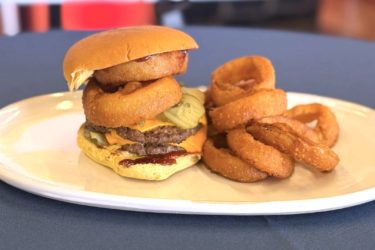The Local newsletter is your free, daily guide to life in Colorado. For locals, by locals.
It’s another sign of the coronavirus times that some local restaurants and food halls have converted into social-distance-friendly markets to survive the state’s mandated dine-in closures. To supplement carryout and delivery sales, these nimble establishments have added staples and grocery items like toilet paper, fresh produce, and canned goods to their menus, exploring new business models to survive. In other words, restaurants have gone retail.
But are consumers forgoing Costco to buy toilet paper and the like from neighborhood eateries? We asked local food halls and restaurants that have dove into the market game whether the grocery sales are doing enough to help them stay open in the long term. Here’s what they had to say.

Food halls, with their cavernous spaces and already-varied offerings, had an advantage when shifting to grocery-style sales. Two in particular, Milk Market and Denver Central Market, were, in fact, designed to be markets, not just food halls. Milk Market owner Frank Bonanno estimates that 80 percent of current sales there are coming from neighborhood residents doing their daily or weekly grocery shopping.
“We’ve had shopping baskets in here from day one,” Bonanno says. “We always wanted to be this place you came to shop for food, not just get a drink and a burger. We were unable to execute it (before the dine-in closures), but we’ve probably sold more fresh pasta in the past month than we did in the past year.”
Still, Bonanno has had to cut employees in a big way—from 250 to about 20—and run Milk Market as a co-op, with his staff receiving 60 percent of sales. (The other 40 percent goes to food costs.)
So, is it working? Not really. “This is not a sustainable model,” Bonanno says. “This isn’t about trying to make money. It’s just about trying to employ people.”
Zach Spott, owner of Green Seed Market at Denver Central Market, came up with the idea to add pick-up and delivery grocery boxes to reactivate his space during the in-person closures. He says the market sold about 200 of the to-go boxes in the past three weeks, with the $135 Big Box (loaded with veggies, desserts, pasta, and meats) and the $45 Italian Family Box (filled with a couple meals’ worth of lasagna and chicken) being the best sellers. “Offering something where we’re a one-stop shop for a handful of meals from local, favorite vendors made a lot of sense,” Spott says.
So, is this model working for Denver Central Market? Again, not really.
“I’d say we’re down 75 to 80 percent of normal volume,” Spott says. “No one’s making anywhere close to what they were previously—I think that’s pretty standard across almost every restaurant out there. Our goal going into it was can we make enough money to pay for our staff and pay for the food we’re buying. That would give us at least some incentive to stay open.”
Restaurants, on the other hand, aren’t as big and don’t typically offer as diverse a food lineup. But many have recently tried to get into the grocery business, too, out of necessity.
“We saw a need in our communities for access to higher quality fresh produce and proteins, particularly in the delivery space,” says Beth Hardy, vice president of marketing for Denver-based fast-casual Modern Market restaurants. “We were hearing stories from guests, friends, and family, and personally experiencing long wait times—days, even up to a week—for grocery delivery…We decided to open our supply chain to guests and allow them to order the same fresh fruits, vegetables, grains, and meats we serve in our restaurants.”
Modern Market started this service on April 1, with three different grocery box options—think: potatoes, beef, milk, pasta, toilet paper, and bread. The company has since added a fourth box and à la carte items, and is adding meal kits in the next week or two. Mod Market won’t release sales details, but Hardy says that sales of the grocery items have been very helpful.
Unfortunately, grocery sales weren’t the savior that downtown restaurant the Lobby needed. After two weeks with barely any revenue coming in, and some days with none at all, the Lobby shut down completely, across both grocery and to-go restaurant sales. “As a smaller brunch restaurant, we’ve never put a huge emphasis on take-away or delivery food, so we went into this with a bit of a disadvantage I think,” says Meg Batizy, operating partner of the Lobby. “We weren’t bringing in enough sales to cover the labor and product.”
Batizy was able to secure a Paycheck Protection Program loan, so she hopes to be open again for takeout and delivery on May 1. She says the Lobby will try grocery sales again, and if they don’t sell, they will donate leftovers to staff, food banks, and hospitals.
Boulder’s Scratch Kitchen, a healthy takeout and delivery-only restaurant that encompasses three different concepts, opened in mid-March, right at the beginning of the COVID-19 closures. Owner Michael Joseph has experience running online grocery services (he co-founded Door to Door Organics and founded Green Chef and Mile High Organics), so even though Scratch wasn’t originally designed to be a grocer, it almost instantly became one. “Our community needed this, and I knew what to do,” Joseph says. “I had the supply chain in place, we had the space, and so we built a grocery store.”
Currently, Scratch Kitchen has 236 grocery items available at its SK Market in addition to its three restaurant menus. You can purchase hand sanitizer, peanut butter, frozen waffles, milk, and cheeses, and you can get it all quick, too; groceries are ready for curbside pick-up within 20 minutes of ordering, and deliveries will be at your door within an hour. “We’re trying to make sure our core customers can get all their daily needs met,” he says, but adds, “Setting up a grocery store in 10 days with this many products has been crazy.”
So far, it’s been working for Scratch. While Joseph says it’s been a struggle to launch a business during this period, sales are ahead of schedule, with both restaurant and grocery sales climbing.
“[Grocery products] are helping with sales. It’s not only working, but this is why we’re adding a bunch more products. This may even become part of our business model,” Joseph says. “This was an unexpected test of what the market needed and having my personal background in direct consumer food business, it was like a moment of service. It needed to happen.”








